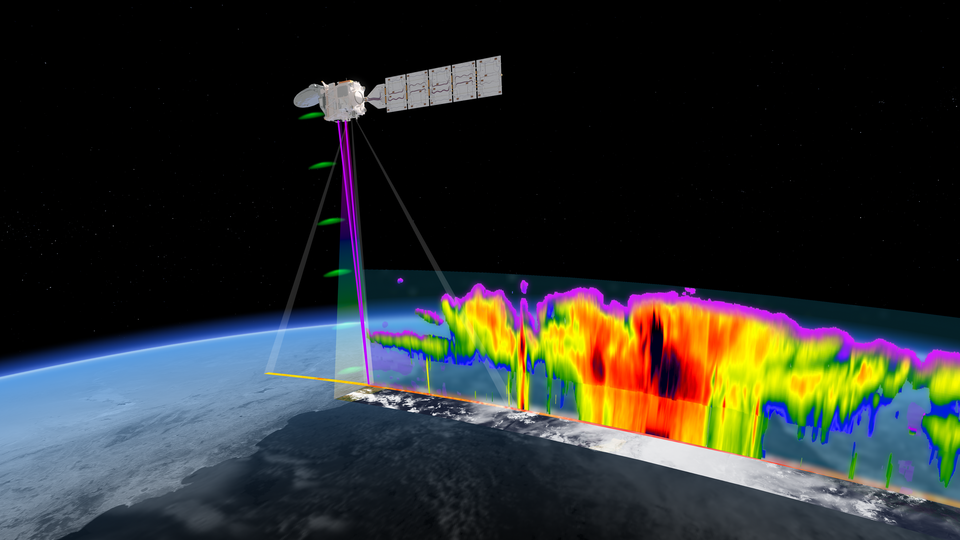Published on 29 May 2024
ESA’s EarthCARE satellite, poised to revolutionise our understanding of how clouds and aerosols affect our climate, has been launched. This extraordinary satellite embarked on its journey into space on 29 May at 00:20 CEST (28 May, 15:20 local time) aboard a Falcon 9 rocket from the Vandenberg Space Force Base in California, US.

The Falcon 9 rocket carrying EarthCARE blast off from Vandenberg
Just 10 minutes later, the satellite separated from the rocket. Then, at 01:14 CEST, the Hartebeesthoek ground station in South Africa received the all-important signal indicating that EarthCARE is safely in orbit around Earth.
With the climate crisis increasingly tightening its grip, the Earth Cloud Aerosol and Radiation Explorer, or EarthCARE for short, will soon be returning crucial information to shed new light on the complex interactions between clouds, aerosols and radiation within Earth’s atmosphere.
This exciting new mission is a joint venture between ESA and the Japan Aerospace Exploration Agency, JAXA.
 EarthCARE deploys solar wing and cloud profiling radar
EarthCARE deploys solar wing and cloud profiling radar
Access the video
ESA’s Director of Earth Observation Programmes, Simonetta Cheli, said, “EarthCARE is the most complex of ESA’s research missions to date. Its development, and now launch, is thanks to close cooperation with our JAXA partners, who contributed the satellite’s cloud profiling radar instrument, and all of the space industry teams involved.
“The mission comes at a critical time when advancing our scientific knowledge is more important than ever to understand and act on climate change, and we very much look forward to receiving its first data.”
JAXA’s Project Manager for the cloud profiling radar, Eiichi Tomita, added, “Increasing the accuracy of global climate models by using EarthCARE data will allow us to better predict the future climate and therefore take necessary mitigation measures. JAXA provided the cloud profiling radar – the world’s first radar that can measure the velocity of upward and downward flow within clouds. We are expecting these EarthCARE data products to be remarkable.”
 EarthCARE separates
EarthCARE separates
Most of us probably perceive clouds as mere fluff in the sky or harbingers of rain, but behind their apparent simplicity, the science is extremely complicated and relatively poorly understood.
Although it is known that clouds play an extremely important role in atmospheric heating and cooling, they remain one of the biggest uncertainties in our understanding of how the atmosphere drives the climate system and, importantly, how they will shape our future climate.
Clouds reflect incoming solar energy back out to space, but they also trap outgoing infrared energy. This leads to either a net cooling or heating effect. However, the extent to which clouds warm or cool Earth depends on various factors including their shape, location, altitude, water content and particle size.
Aerosols are tiny particles such as dust and pollutants suspended in Earth's atmosphere. They also play a significant role in Earth's climate system, both ‘directly’ by reflecting and absorbing incoming solar radiation and trapping outgoing radiation, and ‘indirectly’ as they act as nuclei for cloud formation – which is how they influence our climate the most.
Human activities, including industrial processes, transportation and agriculture are significantly altering concentrations of aerosols in the atmosphere and thereby impacting regional climate patterns.
Although it is understood that clouds and aerosols currently exert an overall cooling effect, changes and feedback loops brought about by the climate crisis could reduce their cooling potential, exacerbating climate change further.
The remarkable EarthCARE satellite carries a set of four state-of-the-art instruments.

EarthCARE for a better understanding of Earth's radiation balance
The cloud profiling radar provides information on the vertical structure and internal dynamics of clouds, the atmospheric lidar delivers profiles of aerosols and thin clouds as well as cloud-top information, the multispectral imager offers a wide-scene overview in multiple wavelengths, and the broadband radiometer measures reflected solar radiation and outgoing infrared radiation coming from Earth.
Unique to the mission is that these instruments will work together to provide a holistic view of complex interplay between clouds, aerosols and radiation, yielding new insight into Earth’s radiation balance against the backdrop of the climate crisis.
The EarthCARE satellite is now being controlled from ESA’s European Space Operations Centre in Darmstadt, Germany. Controllers will spend the next few months carefully checking and calibrating the mission as part of the commissioning phase.
The satellite was designed and built by a consortium of more than 75 companies under Airbus as the prime contractor.
Source:European Space Agency. (2024, May 29). EarthCARE launched to study role of clouds and aerosols in Earth's climate. ESA Observing the Earth. |